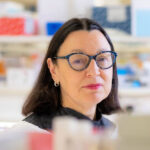Meet the woman who has set to cure Parkinsons

LONDON: One woman in the antipodes has set out on a mission to cure Parkinsons.
Glenda Halliday always knew she would be a scientist. From a young age, she was fascinated by rocks and would study them intensely.
What she didn’t expect was that she would one day go from collecting rocks to collecting human brains.
You would not know Glenda is one of the world’s leading scientists. The quiet, unassuming professor was just named NSW scientist of the year, and she is renowned in the international community. But for Glenda, none of that matters.
There are no awards on the walls of her white office, no trophies gathering dust on her desk — just a laptop and pile of notes.
Glenda’s proudest achievement is the more than 700 brains in Sydney Brain Bank.
She founded the biobanking facility in 2009, creating a space that collects, characterises, stores and distributes human brain and spinal cord tissue for research into disorders of the brain and mind.
For Glenda, awards pale in comparison to the impact of the Brain Bank. It’s for this very reason she will likely be the woman who cures Parkinson’s disease.
When Halliday became a Professor of Medicine in 2003, only 1 per cent of all medical professors were female. Today, that number remains less than 5 per cent. The odds are Glenda should never have risen as far as she has.
But Glenda is used to beating the odds. She completed school in Northern Tablelands of New South Wales and was just one of two people in her class to attend university. Since then, she‘s had one goal – to crack the puzzle that is Parkinson’s disease. And if you ask her colleagues, the odds are, she will.
Simon Lewis, Professor of Neuroscience at the University of Sydney has worked with Glenda for over 16 years. He talks about her with admiration, his voice swelling with respect.
“The bottom line is, I don’t understand why she’s not had an appearance on the honours list. It makes no sense to me whatsoever. She is one of Australia’s leading scientists, if not the world’s.
The great thing about Glenda is she’s an achiever, and she’s sort of a quiet achiever. And the bottom line is, she has a very clear vision about what she thinks needs to be done. The fact of the matter is, she isn’t interested in the fame or the fortune, she wants to find as cure.
I think she is somebody who could really change this field … simply put, Glenda is the sort of person who is actually likely to find a pathway to a cure.”
Glenda straddles a strange balance between life and death.
What sets Glenda apart from others in her field is the work she does before a person has succumbed to a disease. Like most neurodegenerative diseases, true insight cannot be gained about Parkinson’s disease until a person has died, when their brain can be put under a microscope. Yet, for Glenda, some of the most important work she will do, occurs not in death, but in life.
In the weeks, months and years before she receives a donated brain, Glenda works closely with patients, learning everything she can about their life to understand their eventual death. Once they do pass, they have the opportunity to donate their brain to The Sydney Brain Bank, allowing scientists like her to examine Parkinson’s effects on the brain tissue.
Because of this close connection, when Glenda examines a brain under a microscope or cuts into a body for an autopsy, she doesn’t just see a specimen but a person she once knew.
“When I initially set up a lot of the Brain Donor programs, I used to know a lot of the people in the program. There’s been times when I have had gifts from people who have donated brains. I have gone to their house for lunch … I have got to know people very well.
When I started as a very young researcher, I thought, ‘oh, this will be easy’. I‘ll make some discoveries. And hopefully it will help people within five to ten years. So talking to people who had longer duration diseases, it wasn’t such a hard thing to do, because you’d think ‘I will make a big advance’, but many succumbed before we got there.
Glenda fell into neurodegenerative diseases by accident. While studying a psychology unit at university, she realised how little humans knew about the brain.
“Many people think the last frontier is Antarctica, or space, but really the real last frontier is the brain. I never really thought I would look at this, when you realise people don’t know enough about the brain because we can’t look a it, well then you think, we’ve got to look at it.”
It’s this approach to life that has led Glenda so far. no one has focused on non-Alzheimer‘s neurodegenerative diseases, particularly Parkinson’s, like she has. By combining biochemistry, genetics and neuroimaging, her Parkinson‘s research has changed international diagnostic criteria and recommendations for adequate identification and management of patients.
“Is there anything I would do different?”. The question doesn’t come from a journalist’s notepad but from Glenda herself. Pausing, she asks, and answers her own question.
“It would have been good if I could have cured Parkinson’s in the first five or ten years of my career.”
- Glenda Halliday







